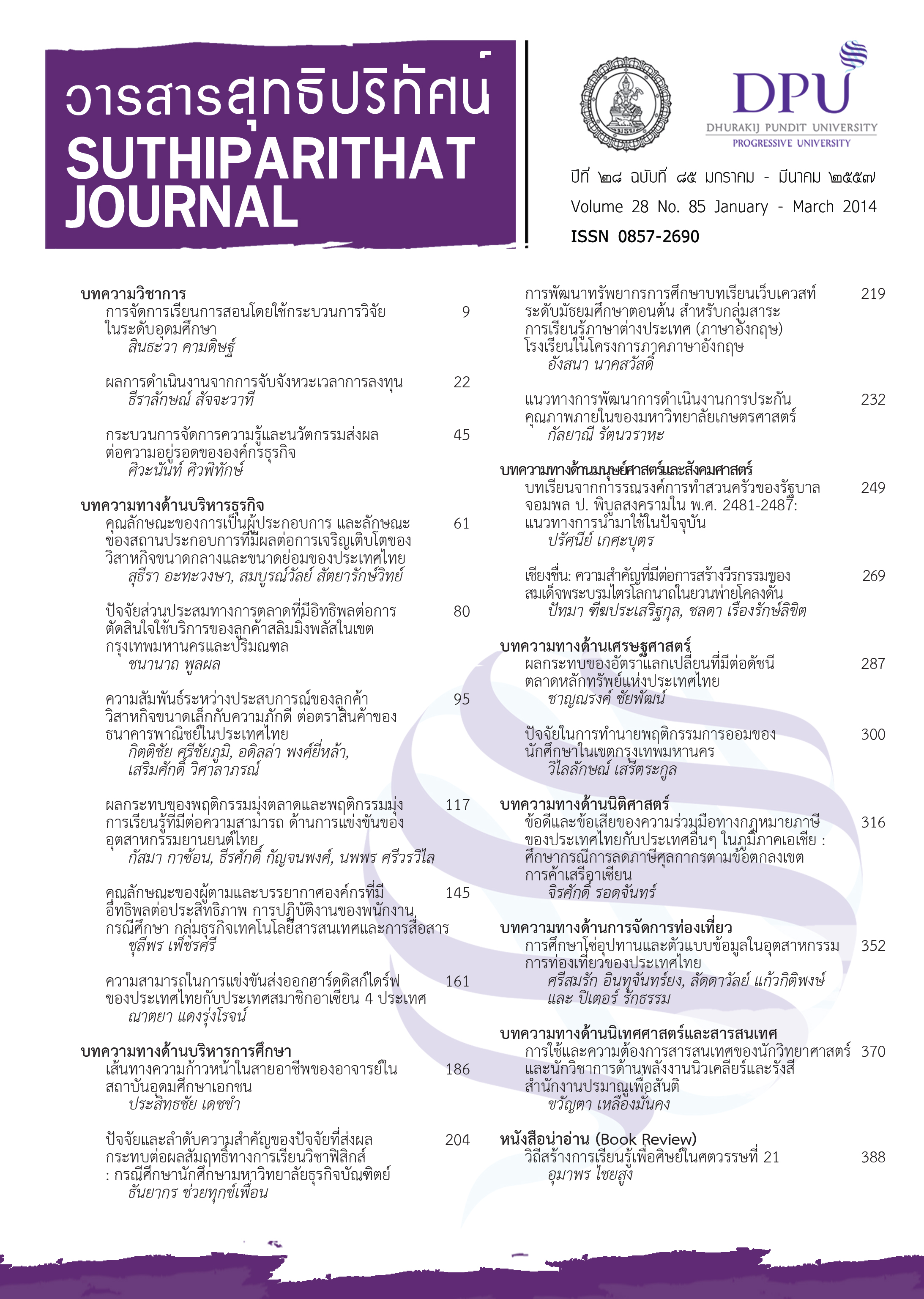การศึกษาโซ่อุปทานและตัวแบบข้อมูลในอุตสาหกรรมการท่องเที่ยวของประเทศไทย
คำสำคัญ:
โซ่อุปทาน, การท่องเที่ยวของประเทศไทย, ตัวแบบข้อมูลบทคัดย่อ
อุตสาหกรรมการท่องเที่ยวไทยมีความสำคัญต่อการเติบโตของเศรษฐกิจประเทศไทย จึงมีความจำเป็นที่จะต้องพัฒนาให้ทุกภาคส่วนในอุตสาหกรรมนี้สามารถที่จะร่วมมือกันได้อย่างมีประสิทธิภาพมากขึ้น เพื่อที่จะนำไปสู่การพัฒนาของอุตสาหกรรมที่ยั่งยืน รวมถึงการศึกษาถึงโซ่อุปทานของอุตสาหกรรมการท่องเที่ยวในประเทศไทยเพื่อสร้างความเข้าใจในภาพรวมของการประสานงานกันระหว่างผู้ประกอบการที่เป็นผู้มีส่วนได้เสียหลักและการแลกเปลี่ยนข้อมูลระหว่างผู้ประกอบการที่เป็นผู้มีส่วนได้เสียแต่ละราย ทั้งนี้เนื่องจากอุตสาหกรรมการท่องเที่ยวเป็นอุตสาหกรรมที่เกี่ยวข้องกับข้อมูลและการประมวลผลข้อมูลเป็นอย่างมาก ดังนั้นหากการแลกเปลี่ยนหรือส่งต่อข้อมูลระหว่างกันในอุตสาหกรรมการท่องเที่ยวเป็นไปอย่างราบรื่นและมีประสิทธิภาพก็จะส่งผลดีต่อทุกภาคส่วนในอุตสาหกรรม
จากการศึกษา พบว่าในผู้ประกอบการที่เป็นผู้มีส่วนได้เสียหลัก 6 กลุ่มประกอบไปด้วย โรงแรมและที่พักตัวแทนการท่องเที่ยว หน่วยงานดูแลและประชาสัมพันธ์การท่องเที่ยวธุรกิจการท่องเที่ยวและกิจกรรมธุรกิจและบริการด้านอาหารและธุรกิจการเดินทาง มีเพียง 2 กลุ่มที่มีความสัมพันธ์กันอย่างใกล้ชิดคือ โรงแรมและตัวแทนการท่องเที่ยว โดยปัญหาที่ผู้ประกอบการเหล่านี้มักประสบในการบริหารจัดการโซ่อุปทานอุตสาหกรรมการท่องเที่ยวแบ่งออกได้เป็น 3 ด้านคือ ปัญหาด้านการจัดการข้อมูลข่าวสาร และความรู้ ปัญหาจากลักษณะการทำงานในบริบทของอุตสาหกรรมการท่องเที่ยว และปัญหาอันเนื่องมาจากการพัฒนาอย่างรวดเร็วทางด้านเทคโนโลยีสารสนเทศ นอกจากนี้คณะผู้วิจัยได้วิเคราะห์และพัฒนาตัวแบบข้อมูลโดยรวบรวมและจัดกลุ่มข้อมูลตามประเภทของผู้ประกอบการและความต้องการใช้งานข้อมูลในการบริหารจัดการโซ่อุปทานของผู้ประกอบการแต่ละกลุ่ม
References
จิตราภา กุณฑลบุตร. (2009). การจัดระบบข้อมูลและสารสนเทศทางการศึกษาในโรงเรียน. สืบค้นเมื่อ 24 กรกฎาคม 2011, http://www.chittrapa.net/index.php?option=com_content&task=view&id=35&Itemid=51
ฉลองศรี พิมลสมพงศ์. (2005). การวางแผนและพัฒนาตลาดการท่องเที่ยว.กรุงเทพฯ: สำนักพิมพ์มหาวิทยาลัยเกษตรศาสตร์.
บุญเลิศ จิตตั้งวัฒนา. การตลาดท่องเที่ยว (Tourism Marketing) สืบค้นเมื่อ 10 กรกฎาคม 2011, http://www.shef.ac.uk/library/libdocs/hsldvc1.pdf.
เมธา ชำนิ. (2001). แบบจำลองอุปสงค์ของการท่องเที่ยว:ปัจจัยที่มีผลต่อรายได้จากนักท่องเที่ยวต่างชาติของประเทศไทย. ระดับ.วิทยานิพนธ์มหาบัณฑิต, สาขาวิชาเศรษฐศาสตร์และการเงินระหว่างประเทศ บัณฑิตวิทยาลัย, จุฬาลงกรณ์มหาวิทยาลัย.
Beamon, B. M. (1998). Supply Chain Design and Analysis: Models and Methods, International Journal of Production Economics , 55(3), p. 281-294.
Buhalis, D. (1998). Strategic use of information technologies in thetourism industry. Tourism Management, 19(5), p. 409–421.
Buhalis, D. (2003). eTourism: Information technology for strategic tourism management. Pearson, Financial Times: Prentice-Hall.
Buhalis, D. and Law, R. (2008). Progress in information technology and tourism management: 20 years on and 10 years after the Internet - The state of eTourism research. Tourism Management, Vol. 29, p. 609–623.
Chaitip, P. and Rangaswamy, N. and Chaiboonsri C. (2006). VECM Model and Modeling International Tourism Demand in Thailand. In: Proceedings of The 7th Asia Pacific Industrial Engineering and Management Systems Conference. Bangkok, Thailand, December 17-20, 2006.
Chaitip, P. et al. (2010). A Structural Equation Model: Greece’s Tourism Demand for Tourist Destination. APSTRACT (Applied Studies In Agribusiness And Commerce), 4(1-2), p. 75-83.
Chaovanapoonphol Y. et al. (2010). Time Series Modelling of Tourism Demand from the USA, Japan and Malaysia to Thailand. University of Canterbury, Department of Economics and Finance.
Claveria, O. and Datzira, J. (2010). Forecasting tourism demand using consumer expectations. Tourism Review, 65(1), p. 18-36.
Christopher, M. (2005). Logistics and Supply Chain Management: Creating Value-Adding Network 3rd ed, Harlow: Prentice-Hall.
Fodness, D., & Murray, B. (1997). Tourist information search. Annals of Tourism Research, 24(3), p. 503–523.
Giacomelli, A. (2006). Tourism Demand.Ph.D. dissertation at the University of Insubria, Italy.
Haliciglu, F. (2004). An ARDL Model of International Tourist Flows to Turkey. Global Business and Economics Review 2004 Anthology, p.614-624.
Hruschka H. and Mazanec.J. (1990). Computer-assisted travel counseling, Annals of Tourism Research 17, p. 208–227.
Jafari, J. (1974). The components and nature of tourism: The tourism market basket of goods and services. Annals of Tourism Research, 1(3), p. 73-89.
Jakkilinki, R., Georgievski, M., and Sharda, N. (2007). Connecting destinations with an ontology-based e-tourism planner. In M. Sigala, L. Mich, & J. Murphy (Eds.), Information and communication technologies in tourism 2007. p. 21–32. Springer Wien.
Kandampully, J. (2000). The impact of demand fluctuation on the quality of service: a tourism industry example, Managing Service Quality, 10, p.10 – 19.
Kampala, R. New-Product Development in Tourism Companies – Case studies on Nature-based Activity Operations,10th Nordic Tourism Research Symposium. Finland, October 18-20 2001.
Lambert, M.D. and Cooper, M.C. (2000). Issues in Supply Chain Management. Industrial Marketing Management Vol. 29, p. 65–83.
Lee, Y.T. and Umeda, S. (2000). An IDEF1x Information Model for a Supply Chain Simulation. [WWW] NIST. Available from: http://www.mel.nist.gov/msidlibrary/doc/idefx.pdf. [Accessed 24/07/11].
Livi, E. (2008). Information technology and new business models in the tourism industry in: Proceedings of the 8th Global Conference on Business & Economics, October 18 – 19, 2008, Florence, Italy
Loban S.R., (1997). A framework for computer-assisted travel counseling, Annals of Tourism Research, 24(4), p. 813–834.
Lohmann, M. (2004). New Demand Factors in Tourism. In: Proceedings of the European Tourism Forum, October 15, 2004, Budapest, Hungary.
Maedche, A., and Staab, S. (2003). Services on the move: Towards P2Penabledsemantic web services. In A. Frew, P. O’Connor, & M. Hitz (Eds.), Information and communication technologies in tourism 2003.ENTER 2003 proceedings. p. 124–133. New York: Springer Wien.
March, R., and Wilkinson, I. (2009). Conceptual tools for evaluating tourism partnerships. Tourism Management 30, p. 455-462.
Mills, J., and Law, R. (2004). Handbook of consumer behaviour, tourism and the Internet. New York: Harworth Hospitality Press.
Morrison, A. M., Jing, S., O’Leary, J. T., & Lipping, A. C. (2001).Predicting usage of the Internet for travel bookings: An exploratory study. Information Technology & Tourism, 4(1), p. 15–30.
O’Connor, P. (1999). Electronic information distribution in tourism and hospitality. Wallingford: CAB.
O’Connor, P., and Frew, A. (2001). Expert perceptions on the future on hotel electronic distribution channels. In P. J. Sheldon, K. W. Wober, & D. R. Fesenmaier (Eds.),Information and communication technologies in tourism 2001 p. 346–357. New York: Springer Wien.
Pease, W.R., Rowe, M. and Copper, M. (2007). Information and Communication Technologies in Support of the Tourism Industry. Idea Group Publishing, United Kingdom.
Pender, L. and Sharpley, R. (2005). The Management of Tourism. London: SAGE Publications Ltd.
Piboonrungroj, P. and Disney, S.M. Tourism Supply Chains: A Conceptual Framework, Exploring Tourism III: Issue in PhD Research. In: Proceeding of the PhD Networking Conference, July 2009. Christel DeHaan Tourism and Travel Research Institute.
Song, H. Witt, SF. and Li, G. (2003) Modeling and forecasting the demand for Thaitourism. Tourism Economics, 9(4), p.363 - 387.
Tapper, R. and Font, X. (2004).Tourism supply chains. Report of a desk research project for the travel foundation. p. 23.Leeds Metropolitan University.
UNWTO.(2008). UNWTO World Tourism Barometer [Online] UNWTO. Available from http://mkt.unwto.org/en/barometer.htm [Accessed: 20 July 2011].
UNWTO.(2009). Tourism: Creating Opportunities in Challenging Times. UNWTO news: Magazine of the World Tourism Organization XXIII.
Venturini, A., and Ricci, F. (2006). Applying Trip@dvice recommendation technology to www.visiteurope.com, 4th prestigious applications of intelligent systems (PAIS-2006). The 17th European Conference on Artificial Intelligence, Riva del Garda, Italy, Aug 28th–Sept 1st, 2006.
Werthner, H., and Ricci, F. (2004). E-Commerce and tourism. Communicationsof the ACM, 47(12), 101–105.
Xinyue, H. (2007). Integrated Tourism Service Supply Chain Management System Basedon SOA. [Online] The Index of Science &Engineering .Available from http://www.seiofbluemountain.com/upload/product/201001/1264392050gkprsnra.pdf. [Accessed 24/07/11].
Zhang, Y. and Murphy, P. (2009). Supply-chain considerations in marketing underdeveloped regional destinations: A case study of Chinese to Goldfields region of Victoria. Tourism Management, 30(2), p. 278-287.
Downloads
เผยแพร่แล้ว
How to Cite
ฉบับ
บท
License
เนื้อหาและข้อมูลในบทความที่ลงตีพิมพ์ในวารสารสุทธิปริทัศน์ ถือเป็นข้อคิดเห็นและความรับผิดชอบของผู้เขียนบทความโดยตรงซึ่งกองบรรณาธิการวารสาร ไม่จำเป็นต้องเห็นด้วย หรือร่วมรับผิดชอบใดๆ
บทความ ข้อมูล เนื้อหา รูปภาพ ฯลฯ ที่ได้รับการตีพิมพ์ในวารสารสุทธิปริทัศน์ ถือเป็นลิขสิทธิ์ของวารสารสุทธิปริทัศน์หากบุคคลหรือหน่วยงานใดต้องการนำทั้งหมดหรือส่วนหนึ่งส่วนใดไปเผยแพร่ต่อหรือเพื่อกระทำการใด ๆ จะต้องได้รับอนุญาตเป็นลายลักษณ์อักษรจากวารสารสุทธิปริทัศน์ก่อนเท่านั้น






